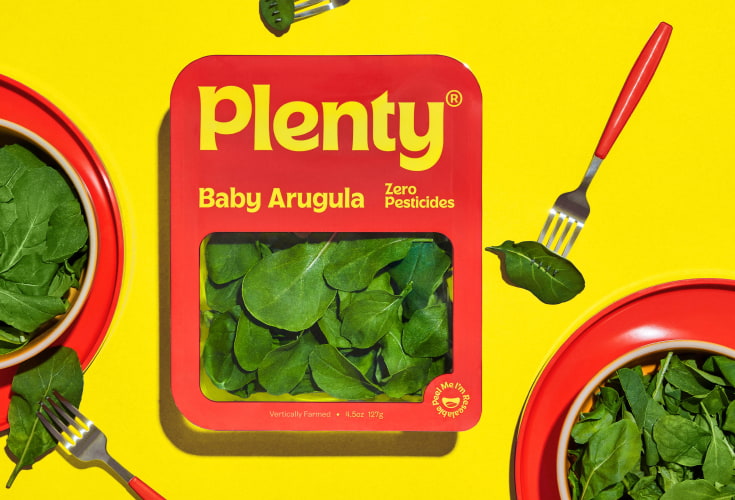Why Plenty Uses Plastic Packaging

Environmental stewardship is the driving force behind Plenty’s mission. At first glance, the choice to package our leafy greens in a plastic container may seem in conflict with our core values. Turns out, finding the right leafy greens packaging solution that balances environmental responsibility, food quality/integrity, shelf life, and food safety is much more complicated than it looks. Packaging that is strong enough to handle being transported, keeps our leafy greens safe and fresh as long as possible and minimizes environmental footprint were among the key criteria for our team as we reviewed packaging options.
We rigorously examined hundreds of packaging designs with the hope of finding a solution that exceeds industry standards. Our first inclination was to turn to biodegradable materials, but we quickly realized the challenge in finding an overall solution that balances all our packaging needs. To our surprise, plastic packaging is currently the best option to balance environmental responsibility, food quality/integrity, and food safety factors.
Our long-term goal is to surpass current industry standards and provide a more environmentally responsible solution while delivering consistently high-quality, well-preserved fresh produce to our customers.
Read on to learn more about the process that led us to our current packaging choices.
Why Not Compostable Packaging?
Since Plenty is rooted in sustainability, we initially sought out materials that are biodegradable. Two primary materials that serve this goal are cardboard and bioplastics. Unfortunately, neither option performs as well as plastic in regard to food quality/integrity, food safety, shelf life, and disposal concerns.
Cardboard
Although cardboard is paper-based and can be recycled, it falls short of preserving the freshness of our leafy greens and keeping our leafy greens safe from contamination as they are transported from our farm to your home. Leafy greens have a high water content, which is naturally released from the leaves over time and can make cardboard packaging soggy and weak. When the packaging environment doesn’t meet the product’s needs, shelf life can be significantly reduced by 40-50%1, leading to increased food waste.
Bioplastics
Bioplastics are made from biodegradables such as cornstarch and sugarcane, which break down into natural substances. The material does a better job at maintaining freshness than cardboard, but it poses added challenges in terms of disposal, production, and overall environmental impact.
The disposal process for bioplastics requires specialized machinery and techniques that many municipally-run waste disposal systems don’t yet possess2. Bioplastics that are either mistaken for petroleum-based plastics or otherwise mishandled will end up in landfills, where they take just as long to decompose as everyday plastics (hundreds of years!). Finally, bioplastics break down at different rates, which means they can contaminate compost and make it unsuitable for agricultural use if processed incorrectly. Bioplastics can actually increase certain aspects of a package’s lifecycle environmental footprint versus petroleum-based materials.3
The Plastic Paradox
Why did we choose plastic packaging over the alternatives? On balance, plastic is currently the most environmentally responsible and effective choice for keeping your greens fresh and protected all while minimizing food waste.
Strength
Our customers need packaging strong enough to preserve the quality of their greens from the moment the package leaves the farm to the moment they enjoy them. Plenty’s current packaging optimizes a balance of strength with the functionality required for our leafy greens.
Plenty is Leading the Pack
We aren’t alone – our entire industry faces these packaging challenges, but Plenty is determined to remain an industry leader in food systems innovation, and thereby honor our core mission. We’re constantly evaluating new materials and technologies for packaging our leafy greens, and look forward to an even more environmentally responsible design. For now, by responsibly managing the life cycle of plastic, we can reduce waste, conserve natural resources, and create a cleaner planet for future generations.
- Internal Plenty shelf life testing results. ↩︎
- A recent GreenBlue study revealed that only 7% of the largest cities have municipally run curbside programs that accept both compostable packaging and food waste. These cities represent just 3% of the total US population. ↩︎
- Janis Brizga, Klaus Hubacek, Kuishuang Feng, The Unintended Side Effects of Bioplastics: Carbon, Land, and Water Footprints, One Earth, Volume 3, Issue 1, 2020, Pages 45-53, ISSN 2590-3322, Article link ↩︎



